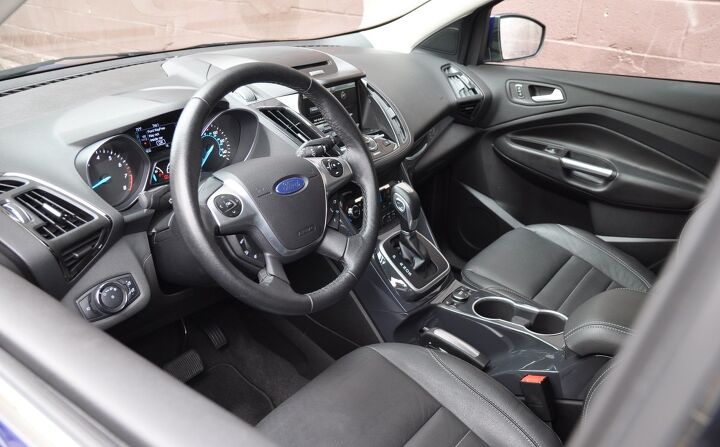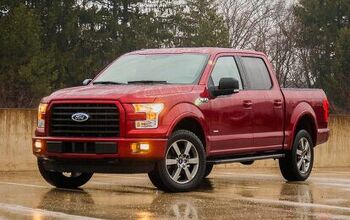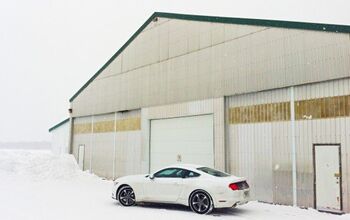Capsule Review: 2015 Ford Escape Titanium

Today’s cute compact crossovers are slowly replacing mid-size sedans as the most popular vehicle on the market, and with good reason too. They have smaller footprints, are easier to drive, are more versatile, more economical, and AWD systems provide a piece of mind during foul weather. Is the Escape a…wait for it…game changer?
The interior is unmistakably Ford, with clear analog gauges and the MyFord Touch system high and center. The seats are very comfortable, heated in the front, and the angle of the headrests is adjustable so they will not press against the back of your head like some other Fords. The rear seat is best for two passengers but three adult butts or three booster seats will fit. The rear bench folds flat and is split 60:40. The dash is made of at least four different types of materials which do not always complement one another or match up perfectly, such as where the A-pillar meets the dash. HVAC controls and other buttons are small, low in the dash, and obscured by the shifter. At night the interior ambiance lighting can be adjusted in color and intensity to match your mood.
The MyFord Touch system received a slew of upgrades over the years and is now actually usable by a novice. Some of the touch-screen buttons are small and shorter drivers may need to stretch to touch the screen. Those truly adventurous can opt to shout at the system to get it to do what they want. The system easily connected to my phone and offers a ton of options and features which will likely go unused by most buyers. An Audi or Lexus-like knob would make this one of the best systems on the market.
The previous generation had large square windows but this one, like the rest of the auto industry, has smaller windows all around. Despite that, visibility in all directions remains surprisingly good. Doors are large and open wide, making the chore of loading kids into the car a task that won’t break your back. Auto up and down on all windows, as opposed to just the driver’s window, is a nice touch. The rear bumper height is low, making loading and unloading easy. The big rear power hatch can be opened by waving your foot under the bumper, but it is slower in operation than other cars.
The top engine choice is a 240hp and 270lb-ft 2.0-liter EcoBoost four-cylinder which is very nicely matched to the vehicle; smooth, quick, and responsive. The six-speed automatic has two driving modes, D and S. In S it downshifts sooner and holds the gears longer, but not too long, where it becomes annoying. The ride is smooth and when tossed into a highway ramp, the Escpape remains neutral and composed, if a bit top-heavy. In this 4WD configuration, the EPA rates the Escape at 21mpg city and 28mpg on the highway. When equipped with a Class II trailer tow package, the little Escape can tow a 3500lb trailer.
The 2015 Ford Escape starts at $22,610 for the base SE model with a 2.5-liter naturally aspirated engine and 2WD. Those wanting 4WD need to step up to the SE with the 1.6-liter EcoBoost engine (178hp/184tq) which starts at $26,810. Our Titanium model, with the 2.0-liter EcoBoost ($1195 over the 1.6-liter), starts at $31,965. Equipment Group 301A adds HID headlights, blind-spot detection, automatic wipers, and parking sensors for $1735. Navigation system is $795 and destination charges are $895 for a total MSRP of $35,150. At the time of this writing there was a $750 factory incentive.
The Escape is a nice vehicle overall, but aside from the peppy engine it does not bring anything new to the market. While none of its competitors feel more exciting in any comparable way, it feels like Ford decided to make just another vehicle to fill the market niche. The powerful engine is nice, but this is a price driven category where competitors offer one engine at a much lower overall price.
Kamil Kaluski is the East Coast Editor for Hooniverse.com. His ramblings on Eastern European cars, $500 racers, and other miscellaneous automotive stuff can be found there.
Ford provided the vehicle for this review.

More by Kamil Kaluski
Latest Car Reviews
Read moreLatest Product Reviews
Read moreRecent Comments
- Redapple2 Love the wheels
- Redapple2 Good luck to them. They used to make great cars. 510. 240Z, Sentra SE-R. Maxima. Frontier.
- Joe65688619 Under Ghosn they went through the same short-term bottom-line thinking that GM did in the 80s/90s, and they have not recovered say, to their heyday in the 50s and 60s in terms of market share and innovation. Poor design decisions (a CVT in their front-wheel drive "4-Door Sports Car", model overlap in a poorly performing segment (they never needed the Altima AND the Maxima...what they needed was one vehicle with different drivetrain, including hybrid, to compete with the Accord/Camry, and decontenting their vehicles: My 2012 QX56 (I know, not a Nissan, but the same holds for the Armada) had power rear windows in the cargo area that could vent, a glass hatch on the back door that could be opened separate from the whole liftgate (in such a tall vehicle, kinda essential if you have it in a garage and want to load the trunk without having to open the garage door to make room for the lift gate), a nice driver's side folding armrest, and a few other quality-of-life details absent from my 2018 QX80. In a competitive market this attention to detai is can be the differentiator that sell cars. Now they are caught in the middle of the market, competing more with Hyundai and Kia and selling discounted vehicles near the same price points, but losing money on them. They invested also invested a lot in niche platforms. The Leaf was one of the first full EVs, but never really evolved. They misjudged the market - luxury EVs are selling, small budget models not so much. Variable compression engines offering little in terms of real-world power or tech, let a lot of complexity that is leading to higher failure rates. Aside from the Z and GT-R (low volume models), not much forced induction (whether your a fan or not, look at what Honda did with the CR-V and Acura RDX - same chassis, slap a turbo on it, make it nicer inside, and now you can sell it as a semi-premium brand with higher markup). That said, I do believe they retain the technical and engineering capability to do far better. About time management realized they need to make smarter investments and understand their markets better.
- Kwik_Shift_Pro4X Off-road fluff on vehicles that should not be off road needs to die.
- Kwik_Shift_Pro4X Saw this posted on social media; “Just bought a 2023 Tundra with the 14" screen. Let my son borrow it for the afternoon, he connected his phone to listen to his iTunes.The next day my insurance company raised my rates and added my son to my policy. The email said that a private company showed that my son drove the vehicle. He already had his own vehicle that he was insuring.My insurance company demanded he give all his insurance info and some private info for proof. He declined for privacy reasons and my insurance cancelled my policy.These new vehicles with their tech are on condition that we give up our privacy to enter their world. It's not worth it people.”






































Comments
Join the conversation
If some of the folks above discussing AWD vs FWD+snow tires were as smart as they seem to think they are, they would stop the tiresome habits of unfair comparisons and confusing technological capability with human behavior. There is no question AWD vehicles have better traction than 2wd. There is no question a car with better clearance will get through rougher stuff than one with lesser clearance. There is no question more clearance leads to a higher center of gravity which will degrade cornering. There is no question snow tires grip better on snow than all-seasons. Yet, some persist in comparing AWD equipped with all-seasons, with 2wd with snow tires. How about making it fair and comparing AWD plus snow tires with 2wd plus snow tires? How about factoring out the skill of the drivers when comparing different vehicle configurations and tire types? Consider what an AWD vehicle with snow tires and a skilled driver can do in snow. Can a 2wd with snow tires and a driver of equal skill match it? Um, no. I agree that like many features and for many car buyers, AWD is yet another feature that allows manufacturers to condition the public into believing an increasingly upscale vehicle is the minimum equipment level for an acceptable purchase. But AWD probably offers a better value proposition than, say, expensive artsy proprietary headlight clusters or padded surfaces no one will ever touch.
The cell phone Millennial look dash, boring blah grey/charcoal interior and monotone look do not make me think 35 grand. And I still wonder how these highly stressed turbo 4 bangers are going to hold up in the real world, especially after towing. The exterior styling really does little to raise my heartbeat either. I can go right across the street to the Hyundai store and get a V6, larger cargo area and much more pleasing interior looks/quality for this kind of coin!